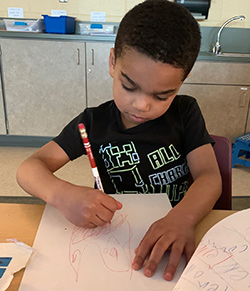As they sat at a round table, Young Fives student Joel Lozada knew what to do with the tile letters in front of him.
“Let’s start with a two-letter word: ‘as,’” paraprofessional Carla Schuch instructed. Joel lined up an A and S, smiling as he did so.
“Change it to ‘at’,” Schuch said, and Joel replaced the S with a T.

They moved on to three-letter words: sat, day and ray. After Joel successfully spelled out the four-letter word “tray” with his tiles, it was time to switch stations. Joel plucked the book “Does a Kangaroo Have a Mother Too?” by Eric Carle, out of the classroom library and settled with it on the floor.
Joel, whose grin is ever present, has speech that is sometimes difficult to understand. But in the Literacy Center at Discovery Elementary School, he is learning to read. He shows what he knows using the letter tiles and writing to teacher Mikayla Goldsmith, speech language pathologist Jackie Gale and paraprofessional Karla Schuch. He also uses a Pragmatic Organization Dynamic Display (PODD) book, which contains pictures Joel can point to and use to express himself.
Around him, students are busy with reading and writing activities. Some who also have speech that is hard to understand use augmentative and alternative communication (AAC) devices that have digital pictures and automated words.
Literacy Instruction
The center serves students who are on the autism spectrum and those with other impairments with focused literacy instruction.
Gale is a fierce proponent of providing literacy instruction to all students — no matter what. If they can breathe, she said, they need reading instruction, access to books and tactile ways to learn letters. They need to be read to as well, and given the chance to learn to read.
“At the core of these practices is that all students can learn to read and write in ways that allow them to interact meaningfully with the world around them, and that there are no prerequisites to being taught to read and write.”

Gale and special education teacher Mikayla Goldsmith collaborated to spearhead the literacy center last year to serve students who have a range of skills. Some are still learning the fundamentals, others are able to read on their own. Two even have hyperlexia — a precocious ability to read– and focus on comprehension.
“These students need more time often to learn to read, write, listen and speak,” Gale said. “We are working on skills in a concentrated fashion and we are giving them multiple, multiple, multiple opportunities throughout the day.”
Instruction is based on the research of Karen Erickson and David Koppenhaver, who have compiled best practices for developing literacy skills in students with significant disabilities. Gale studied under Erickson and Koppenhaver at Camp ALEC, a Grand Rapids-based camp to empower children who have severe impairments with language and literacy. At the camp, Erickson and Koppenhaver provide instruction to educators as literacy counselors. Gale and speech pathologists Megan Hojnaki, from Caledonia Public Schools and Bethany Vandenbrand, from Grandville Public Schools, were trained in the method to train others.
Students are making big progress — showing they are capable of a lot, Gale said. Those in the program since September know most of their letters and sounds, and are beginning to decode words and use letters to write words, as Joel demonstrated. They listen to stories with some degree of concentration, and are getting into the habit of sitting down with a book independently, Gale said.
In a writing station, Kameron McGowan wrote down his own name and the names of his friends: DJ, Joel, Adrian, Xavier and Ron. He was writing a story. “All of these kids are going to recess,” he explained.

Focused Time on Literacy
For the Literacy Center model to work, Gale said, students must be given the chance to learn to read, write, decode, spell and listen for meaning in a language-rich environment at least two hours a day with another half hour spent on the student’s individual area of greatest need. At Discovery, students spend an hour each day in the Literacy Center and focus on literacy in other classrooms throughout the day.
Goldsmith, who was trained in the process under Gale and teaches in the center, said students are showing growth.
“I’ve seen huge progress with them,” she said. Assessments show three-fourths of the students are on grade level. “The ones who aren’t at grade level have made almost a whole year’s growth. It proves that it works.
“They have been improving so much,” Goldsmith said. “They have so much up there.”












